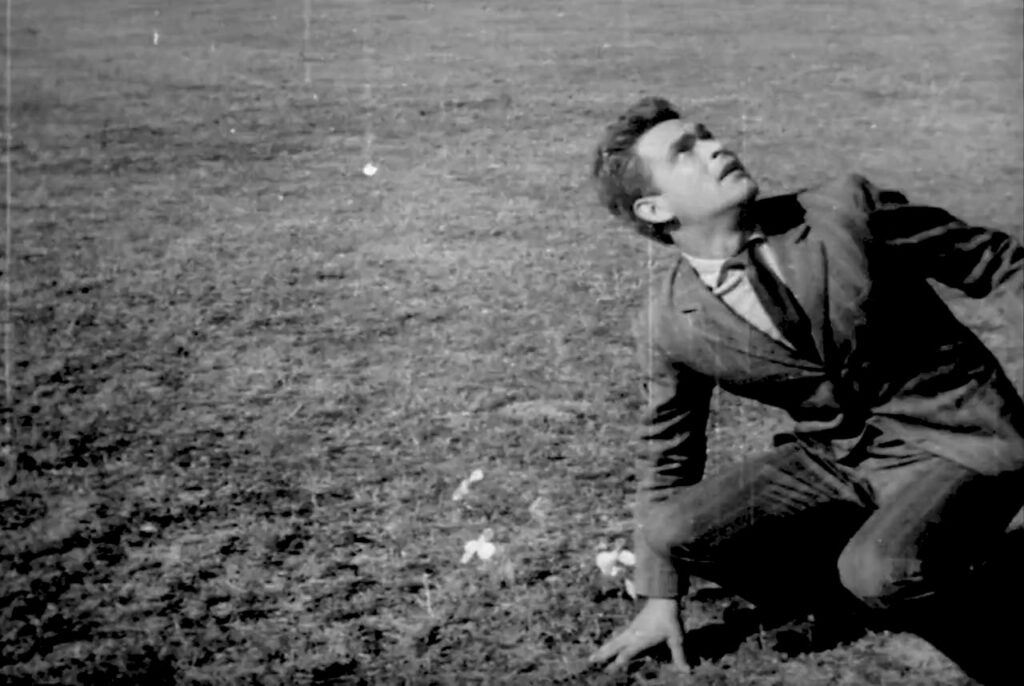The Romanian animator Ion Popescu-Gopo’s live-action film S-a Furat o Bombă (translated as A Bomb Was Stolen or They Stole the Bomb) was selected to compete for the Palme d’Or at Cannes in 1962. It had very little chance of winning, since it was up against Bresson’s The Trial of Joan of Arc, Varda’s Cléo de 5 à 7, Buñuel’s The Exterminating Angel, Antonioni’s L’Eclisse and Satyajit Ray’s Devi. But it was there, an achievement in itself for someone who’d never made a live-action film before. Popescu-Gopo’s animated short, Scurtă Historie (A Brief History) had won the Short Film Palme d’Or in 1957.
It’s also a film without dialogue, another potential handicap, though Cannes juries do love an intellectual-looking gimmick, so who knows. And it’s short, at around 70 minutes, and even at that length feels like it’s been padded.
As well as an animator, Popescu-Gopo was a graphic designer. Which helps explain the strong lines and starkness of image he uses as he tells his story about a man who unwittingly picks up a stolen nuclear weapon and then carries it around all day while the gangsters who originally stole it and the cops looking for it chase around looking for it.
It’s constructed as a “whoops there nearly goes the end of the world” running gag. The man (Iurie Darie) wanders about in Buster Keaton obliviousness. The caricature gangsters – if their safecracker had a name it would be Johnny Fingers – dress like something from the Depression era. The cops charge around en masse, often in speeded-up highly choreographed formation, with Keystone overtones. And that’s about it, apart from a couple of cutaways – to the gang boss and his moll dancing, for instance – that feel as if dropped in to nudge the running time upwards.
There are some lovely visual touches – a 1960s computer consisting of a brain in a tank of liquid connected up to a keyboard, a montage segment set in a cinema lobby where Popescu-Gopo assembles his own thumbnail Wolfman movie out of lobby stills – with the suspicion gradually taking shape that Popescu-Gopo isn’t that interested in his storyline at all. He seems more excited by visual ideas and appears to have a bag of them he wants to empty out into whatever receptacle is waiting.
But eventually the semblance of a story re-asserts itself as the man, called Om – a joke about serenity in the face of annihilation? – falls for a conductress (Eugenia Balaure) on a passing tram (we know he’s fallen for her because every time he looks at her she sprouts little angel wings) and they start kicking about together in a gooey Chaplin-esque reverie.
The action is obviously set in some almost cartoon-like approximation of the USA, so make of that what you will in terms of a critique of capitalism, but the love story is Popescu-Gopo’s own rejoinder to that – communism’s campaign against the individual was far-reaching but it was wary about taking arms against the notion of romantic love.
Time has not been kind to this film, neither in terms of critical standing or its physical condition – unless there’s a new restoration out there, chances are the image you see will be scratchy, damaged, with a tendency at times to dissolve into high contrast blocks of black and white which make some stretches of it a far from ideal viewing experience.
But the ideas and graphic images are so unadorned that there’s never any real problem working out what’s going on. There is a pie fight at one point, for instance, and a pie fight can be spotted from space.
In the end 1962’s Palme d’Or was won by O Pagador de Promessas by Anselmo Duarte, a religious allegory that made Duarte the first Brazilian to win at Cannes. You don’t hear much talk of that film all these years later either.
S-a Furat o Bombă aka A Bomb Was Stolen – Watch it/buy it at Amazon
I am an Amazon affiliate
© Steve Morrissey 2023


